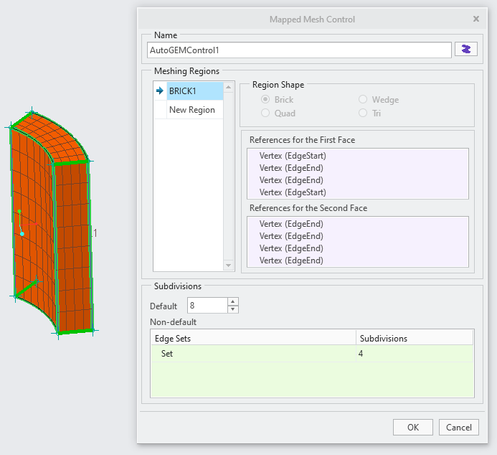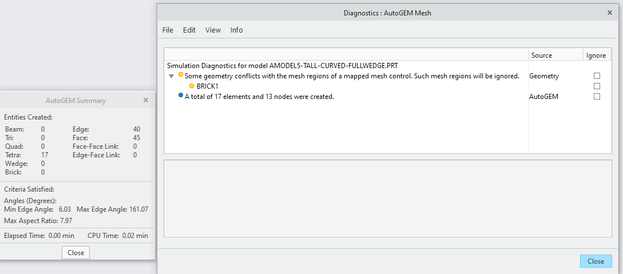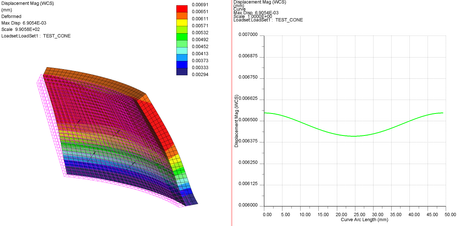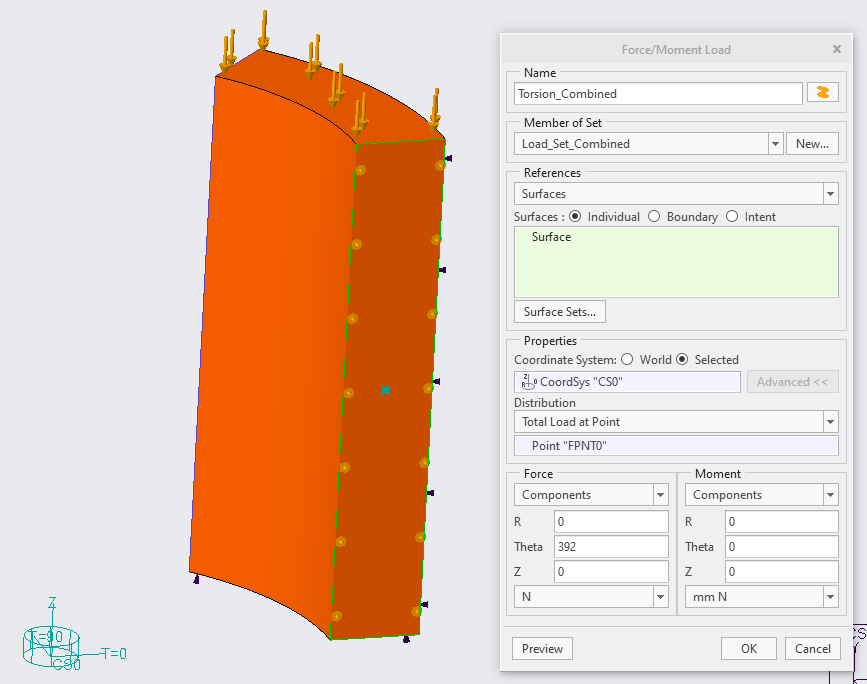Community Tip - Did you know you can set a signature that will be added to all your posts? Set it here! X
- Community
- Creo+ and Creo Parametric
- Analysis
- Mapped Mesh doesn't work on a very simple part
- Subscribe to RSS Feed
- Mark Topic as New
- Mark Topic as Read
- Float this Topic for Current User
- Bookmark
- Subscribe
- Mute
- Printer Friendly Page
Mapped Mesh doesn't work on a very simple part
- Mark as New
- Bookmark
- Subscribe
- Mute
- Subscribe to RSS Feed
- Permalink
- Notify Moderator
Mapped Mesh doesn't work on a very simple part
Creo 9.0.7.0. T5 license
I'm trying to create a mapped mesh on very simple shape. But when I try to create the mesh it fails to make bricks and reverts to tets. I've spent a lot of time trying to do this very simple task and I am frustrated.
My geometry an extruded sketch. It has (or had) some fillets on the vertical edges but I have suppressed them. I have selected every surface combination possible (there are 3 possibilities - top+bottom, the two sides, and the ID and OD).
- Labels:
-
Creo Ansys Simulation
- Tags:
- mapped mesh
- Mark as New
- Bookmark
- Subscribe
- Mute
- Subscribe to RSS Feed
- Permalink
- Notify Moderator
I only have Creo Simulate Advanced 2 ( or 3).
Here is my model in Creo 2, does it work for you?
- Mark as New
- Bookmark
- Subscribe
- Mute
- Subscribe to RSS Feed
- Permalink
- Notify Moderator
Thank you Skunks. Your geometry was more complex than mine (you made a cone and I made a section of a cylinder) and you helped me think things through.
The problem is that I applied a load using the "total load at point" option . Which appears to be the only way to apply a force in a cylindrical coordinate system such that it can be analyzed using non-linear analysis. My attempts to work around this problem have failed, but when I suppress this load it meshes. Which makes sense - the mesher wants to put a node where I applied the force, but I randomly selected the point and it is not associated with any geometry and is not where a node is created by the mesher, so it creates a meshing conflict. I have since created a datum point (and a simulation point) in the geometric center of the face hoping that if the datum point was at the location of a node mapped meshing would work, but it doesn't. I have determined why mapped meshing didn't work, but I have yet to overcoming the challenge of applying a load to the face (in a cylindrical coordinate system) so I can run the model non-linear.
This is preventing me from map meshing bricks:
- Mark as New
- Bookmark
- Subscribe
- Mute
- Subscribe to RSS Feed
- Permalink
- Notify Moderator
..."total load at point"...
For "total load at point", I would click on a corner point.
PS: example attached
- Mark as New
- Bookmark
- Subscribe
- Mute
- Subscribe to RSS Feed
- Permalink
- Notify Moderator
Thanks again Skunks. I gave up on the mapped mesh, turned my point in the middle of the face into a hardpoint, and set a maximum element size. This resulted in a higher density tet mesh, applied the force evenly to the surface, and eliminated my buckling problem, which was occurring due to a bad element shape. However; I do like your meshing approach better than the approach I used so I may give it a try.
I am trying to model an elastomer with a modulus of 1 MPa. Modeling an elastomer has many challenges. I solved the buckling problem due to the element shape, but more buckling problems exist at higher loads and these are due to boundary conditions. If I could create a constraint which sets displacements on a surface equal, but not a prescribed amount of displacement (I am applying a force to these surfaces), I could create realistic boundary conditions. To my knowledge this is not possible, so I believe I must model and simulate an assembly. I may also need to use a hyperelastic material model. I was hoping I could keep my analysis simple but the complexity is increasing.
- Mark as New
- Bookmark
- Subscribe
- Mute
- Subscribe to RSS Feed
- Permalink
- Notify Moderator
Hello @drush,
It looks like you have some responses on your topic. If any of these replies helped you solve your question please mark the appropriate reply as the Accepted Solution.
Of course, if you have more to share on your issue, please let the Community know so other community members can continue to help you.
Thanks,
Community Moderation Team.





